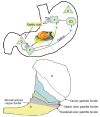Gastric atrophy, diagnosing and staging
- PMID: 17007038
- PMCID: PMC4100653
- DOI: 10.3748/wjg.v12.i36.5757
Gastric atrophy, diagnosing and staging
Abstract
H. pylori is now accepted as the cause of gastritis and gastritis-associated diseases, such as duodenal ulcer, gastric ulcer, gastric carcinoma, and gastric MALT lymphoma. The natural history of H. pylori gastritis includes inflammation progressing from the antrum into the adjacent corpus resulting in an atrophic front of advancing injury leading to a reduction in acid secretion and eventual loss of parietal cells and development of atrophy. Sub-typing intestinal metaplasia has no clinical value to the patient, the pathologist, or the endoscopist. The pattern, extent, and severity of atrophy, with or without intestinal metaplasia, is a far more important predictor than is intestinal metaplasia subtype. The challenge remains to identify a reliable marker that relates to pre-malignant potential.
Figures


Similar articles
-
[Histopathology of Helicobacter pylori infections].Acta Med Austriaca. 2000;27(4):100-3. doi: 10.1046/j.1563-2571.2000.00032.x. Acta Med Austriaca. 2000. PMID: 10989676 Review. German.
-
Comparison of Helicobacter pylori infection and gastric mucosal histological features of gastric ulcer patients with chronic gastritis patients.World J Gastroenterol. 2005 Feb 21;11(7):976-81. doi: 10.3748/wjg.v11.i7.976. World J Gastroenterol. 2005. PMID: 15742399 Free PMC article.
-
[Helicobacter pylori. Its relationships and morphological controversies].Rev Gastroenterol Mex. 2000 Oct-Dec;65(4 Suppl 2):34-40. Rev Gastroenterol Mex. 2000. PMID: 11464620 Review. Spanish.
-
Aging increases, and duodenal ulcer reduces the risk for intestinal metaplasia of the gastric corpus in Japanese patients with dyspepsia.J Gastroenterol Hepatol. 2001 Jan;16(1):15-21. doi: 10.1046/j.1440-1746.2001.02380.x. J Gastroenterol Hepatol. 2001. PMID: 11206310
-
Gastric ulcer, atrophic gastritis, and intestinal metaplasia caused by Helicobacter pylori infection in Mongolian gerbils.Scand J Gastroenterol. 1998 May;33(5):454-60. doi: 10.1080/00365529850171990. Scand J Gastroenterol. 1998. PMID: 9648982
Cited by
-
Operative link for gastritis assessment vs operative link on intestinal metaplasia assessment.World J Gastroenterol. 2011 Nov 7;17(41):4596-601. doi: 10.3748/wjg.v17.i41.4596. World J Gastroenterol. 2011. PMID: 22147965 Free PMC article.
-
Interleukin-1beta promotes gastric atrophy through suppression of Sonic Hedgehog.Gastroenterology. 2010 Feb;138(2):562-72, 572.e1-2. doi: 10.1053/j.gastro.2009.10.043. Epub 2009 Oct 31. Gastroenterology. 2010. PMID: 19883649 Free PMC article.
-
Mucins, trefoil factors and pancreatic duodenal homeobox 1 expression in spasmolytic polypeptide expressing metaplasia and intestinal metaplasia adjacent to gastric carcinomas.Arch Med Sci. 2013 Aug 12;16(6):1402-1410. doi: 10.5114/aoms.2013.36923. eCollection 2020. Arch Med Sci. 2013. PMID: 33224340 Free PMC article.
-
The use of a second biopsy from the gastric body for the detection of Helicobacter pylori using rapid urease test.Singapore Med J. 2014 Dec;55(12):644-7. doi: 10.11622/smedj.2014178. Singapore Med J. 2014. PMID: 25630318 Free PMC article.
-
Gastric endoscopy in the 21st century: appropriate use of an invasive procedure in the era of non-invasive testing.Dig Liver Dis. 2008 Jul;40(7):497-503. doi: 10.1016/j.dld.2008.02.032. Epub 2008 Apr 9. Dig Liver Dis. 2008. PMID: 18403275 Free PMC article. Review.
References
-
- Stemmermann GN, Hayashi T. Intestinal metaplasia of the gastric mucosa: a gross and microscopic study of its distribution in various disease states. J Natl Cancer Inst. 1968;41:627–634. - PubMed
-
- Lambert R. Chronic gastritis. A critical study of the progressive atrophy of the gastric mucosa. Digestion. 1972;7:83–126. - PubMed
-
- Burstein M, Monge E, León-Barúa R, Lozano R, Berendson R, Gilman RH, Legua H, Rodriguez C. Low peptic ulcer and high gastric cancer prevalence in a developing country with a high prevalence of infection by Helicobacter pylori. J Clin Gastroenterol. 1991;13:154–156. - PubMed
-
- Faber K. Chronic gastritis: its relation to achlorhydria and ulcer. Lancet. 1927;2:902–917.
-
- Graham DY. Helicobacter pylori: its epidemiology and its role in duodenal ulcer disease. J Gastroenterol Hepatol. 1991;6:105–113. - PubMed
Publication types
MeSH terms
LinkOut - more resources
Full Text Sources
Medical

